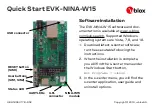
L-VIS User Manual
20
LOYTEC
Version 6.2
LOYTEC electronics GmbH
2.2.4 New Action: Show Pop-Up
A new action type was added to easily build pop-up windows. Instead of placing a
collection on the page and controlling visibility via a trigger, the collection can now be
moved below a pop-up action and visibility will be controlled by the action. In case the
action is connected to a control on the page, the pop-up can be auto-placed near the control
triggering the pop-up action. This enables new design patterns, especially for libraries,
which were not possible before.
2.2.5 Number Control: Show Units
The number control now supports place holder tags in the format string to automatically
insert the effective engineering unit of the connected data point. Together with the new
option to select SI or U.S. unit system during run time, projects can now be designed to
handle both unit systems without any changes to the project itself.
2.2.6 Sound Action: Playback volume adjustment
To improve control of sound volume for individual sounds, every sound and buzzer action
now provides a new option to adjust the playback volume by up to +12dB and -40dB. This
allows the project designer to use the same sound in different situations and play it louder
or softer as needed. This option is only available on LVIS-3ME devices.
2.2.7 LWEB projects: Option to use client-side fonts
To reduce the size of LWEB projects and speed up loading on the client, fonts in LWEB
projects may now be marked as ‘installed on the client’. In this case, the original font data
will no longer be embedded in the project. Instead, meta-information is stored for the
LWEB-802 client to be able to find a suitable pre-installed font on the client machine.
2.2.8 Improved handling of templates
Various improvements have been made to the way templates and their instances are
handled. Most importantly, renaming a data point folder which is part of a template or
template instance base path no longer breaks the base path. Instead, affected base paths are
adjusted to reflect the change. Also, changing the base path of a template tries to remap any
data points which were relative to the old path to match available points under the new
path. This simplifies changes in data point structure after templates and their instances were
already created.
2.3 New in L-Vis 5.1.0
This section describes major changes and new features in L-Vis 5.1.0
2.3.1 Support for new models
This is the first version supporting the new LVIS-3ME model series. Note that since the
LVIS-3ME family is based on a different hardware platform, a different firmware image
must be used (lvis_3me_5_1_0.dl). The new devices support CEA709 as well as BACnet
communication at the same time, so there are no separate models for CEA709 and BACnet.
The LVIS-3ME12 and LVIS-3ME15 are 100% backwards compatible to projects created
for their predecessors LVIS-3E112/ME212 and LVIS-3E115/ME215 respectively.
2.3.2 Math objects as input data points
L-Vis math objects can now be used in all places where input data points can be used,
including cascaded math objects. This saves on internal registers for calculation results and
keeps the project simple, because the formula is located at the exact place where its result is
being used. It is no longer necessary to locate the math object, identify the register used for
the calculation result and searching for the place where this register is finally used as input.
















































